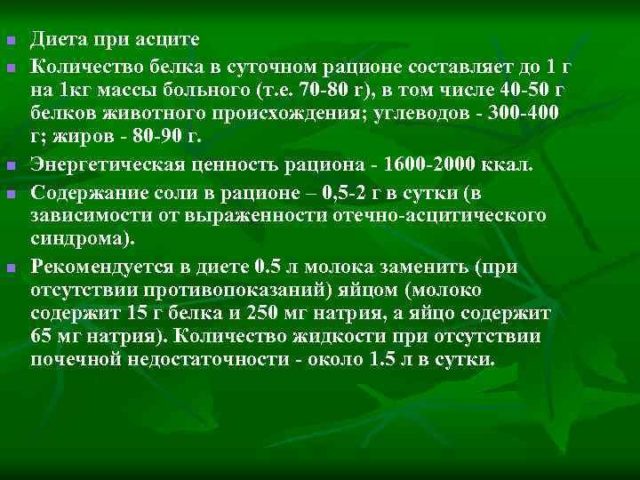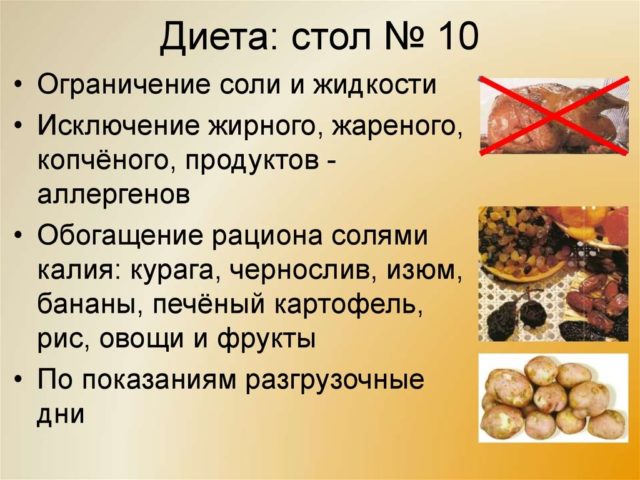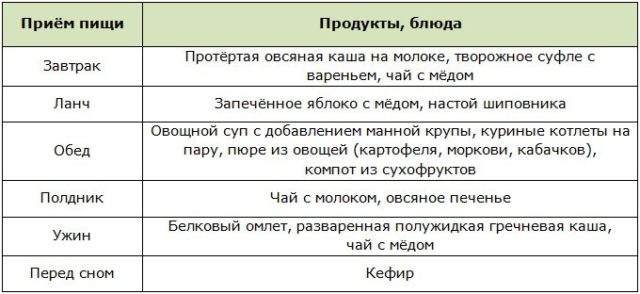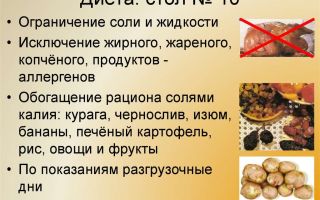Content
Ascites is usually understood as the accumulation of fluid in the abdominal cavity. This disease does not occur on its own. Other, more serious pathologies become the cause. Often, dropsy manifests itself as a result of liver cirrhosis or cancer of the abdominal organs. When the first symptoms occur, treatment should be started as soon as possible. At the same time, patients are often prescribed a diet for ascites.
Basic nutritional rules for ascites
If the patient is diagnosed with dropsy, it is necessary to adhere to a strict diet for ascites.
Doctors always give several basic recommendations:
- Salt is completely removed from the diet. This product promotes fluid build-up, resulting in increased swelling.
- The patient should refuse fresh white bread, muffins.
- Diet with ascites prohibits eating fried and fatty foods.
- You can not use sausages, smoked meats, fatty meats and fish.
- To quickly remove fluid from the body, you should include in the diet foods that have a diuretic effect, in the form of watermelon, radish, cucumber, melon, beet, carrot, pumpkin, radish, asparagus, spinach, artichoke, rose hips, cranberries.
- Diet with ascites excludes a decrease in fluid intake. You need to drink up to 2 liters of water per day. In addition, the menu includes green tea, rosehip broth, chamomile drink, fruit and vegetable juices, compotes.
- Frequency rate of food intake - up to 6 times a day at regular intervals.
- Food is served warm. Before this, the dish is crushed to a puree state.
- The basis of the diet is formed by complex carbohydrates in the form of cereals, pasta and vegetables. Protein diet with ascites is strictly prohibited.

Allowed Products
Diet for ascites is one of the main components of treatment. If all the recommendations are followed, it is possible to speed up the process of excreting fluid and improve the general condition of the patient.
The diet is nutritious. It is rich in carbohydrates. At the same time, proteins and fats are included in a small amount. Food is steamed or boiled.
Diet for ascites involves the use of:
- vegetables and herbs - artichoke, eggplant, green peas, cabbage, broccoli, green and onions, carrots, cucumbers, olives, bell peppers, parsley, radishes, beets, celery, asparagus, tomato, pumpkin, dill, garlic and spinach;
- fruits and berries - watermelon, melon, lingonberry, viburnum, cranberry, rose hips;
- cereals and cereals - buckwheat, oatmeal, rice;
- white bread croutons;
- cumin;
- dairy products - low-fat kefir, natural yogurt without additives, cottage cheese;
- lean meats - rabbit, turkey, chicken;
- seaweed;
- vegetable oils - flaxseed, olive.
If we talk about drinks, then the patient with ascites is recommended to take instant chicory, green tea, rosehip broth, fruit and vegetable juices.
Partially restricted products
The diet for ascites includes foods that can be consumed in small quantities and not often. This includes veal. The meat can be boiled or steamed.
Patients with ascites can eat eggs, but not more than 3 times a week. It is allowed to cook omelets, but without adding yolk.
1-2 times a week in the diet include sweet foods in the form of marshmallows or fruit jelly. You can add a little honey to drinks. It is allowed to eat nuts and dried fruits 2-3 times a week.
Prohibited foods for ascites
Diet with ascites completely excludes the use of fatty and fried foods. To prevent liquid from retaining in the body, it is not recommended to add salt and other spices to food.

Also, the list of prohibited foods includes:
- some types of vegetables and herbs - canned, potatoes, celery, pickled tomatoes;
- bananas;
- fried and pickled mushrooms;
- potato chips;
- dumplings, dumplings;
- buns, white bread;
- cakes, ice cream, preserves, jam, sweets, chocolate;
- sugar;
- dairy products with a high proportion of fat;
- fatty meats - pork, beef, lard, beef liver, bacon, ham, duck, goose;
- sausages;
- fatty fish - salmon, trout, sardine, salmon, tuna;
- animal fat.
Diet No. 10 for abdominal ascites
Before starting to follow a diet with ascites, you need to find out what is the reason for the accumulation of fluid in the abdominal cavity. Table 10 is indicated for people with heart ischemia, arterial hypertension, myocardial infarction and liver cirrhosis.
The nutritional features are as follows:
- The body should receive no more than 2600 calories per day.
- The total amount of salt is reduced to 5 g daily.
- Reduce the amount of fats to 70 g and proteins to 90 g. In this case, 350 g of carbohydrates should be supplied per day.
- Dishes are served boiled or steamed. It is strictly forbidden to eat fast food, convenience foods, chips and snacks.
After an accurate diagnosis has been made, patients with ascites are given several recommendations:
- The diet consists of chicken and vegetable broths, cereals in milk or water with dried fruits and nuts.
- You can eat rye bread croutons.
- The body should always receive proteins, but in small quantities. Therefore, patients with ascites can eat low-fat boiled meat.
- Vegetables are baked or stewed, and then crushed until puree.
- You can eat some berries and fruits that have a diuretic effect.
- The amount of liquid consumed per day does not exceed 1 liter.

Diet for ascites with oncology
With oncological diseases, in 50% of all cases, fluid accumulation in the abdominal cavity is found.
Some pathologies can lead to ascites:
- ovarian cancer;
- malignant formations in the mammary glands;
- uterine cancer;
- stomach or colon cancer.
With such diseases, the abdominal cavity is affected. Often, ascites affects patients who have previously been diagnosed with liver cirrhosis.
A large belly brings a lot of inconvenience. If no measures are taken, the disease will progress further. If doctors diagnose a severe case, then the patient undergoes laparopentesis, thereby pumping out the accumulated fluid. At the end of the operation, the patient is prescribed a diet after ascites.
Doctors categorically prohibit eating harmful and fatty foods. The amount of water per day is reduced to 800-1000 ml. Liquid should not be allowed to continue to accumulate in the abdominal cavity. Dishes are steamed, boiled or baked. The diet for ascites allows the use of soups with the addition of herbs.
If cancer patients have been diagnosed with an advanced form of the disease, then they are prescribed a diet for ascites No. 5. Then the diet includes low-fat cottage cheese, non-acidic fruits and berries, meat and fish products of low-fat varieties.
Diet for cirrhosis of the liver with ascites
Liver cirrhosis is considered the final stage of diffuse morphological changes in the liver. There is a violation of the structure of the lobular structure of the organ. If left untreated, abdominal tissue is damaged, leading to fluid accumulation.

Patients with liver cirrhosis and ascites are prescribed diet No. 5. A number of products are excluded from the diet in the form of:
- canned food;
- sausages;
- fatty meats and fish;
- concentrated broths;
- refractory animal fats;
- vegetables with a high content of coarse fiber and essential oils - radish, radish, onion;
- mushrooms;
- marinades.
Methods for preparing dishes while following a diet with ascites - cooking, stewing and baking.
Patients with ascites are prescribed a low-salt diet. At the same time, fluid intake is limited. Simultaneously with the diet, the patient is given diuretic therapy.
If the symptoms of ascites continue to increase, then the salt is completely limited. The menu includes foods that are fortified with potassium. Lemon or tomato juice, as well as cinnamon, caraway seeds and turmeric can help improve the taste. The amount of proteins and fats is reduced to 20-30 g per day.
Approximate menu for a week with ascites
Doctors believe that the diet for ascites must be followed for life. This will allow not only to improve the general condition of the patient, but also to quickly recover.
An example menu might look like this.
First day:
- In the morning - oatmeal in the water with dried fruits, green tea.
- For lunch - low-fat cottage cheese.
- In the afternoon - vegetable soup, chicken fillet and boiled rice, compote.
- For an afternoon snack - steamed protein omelet, rosehip broth.
- In the evening - buckwheat porridge, berry juice.
On second day:
- In the morning - rice porridge with diluted milk, chamomile tea.
- Melon for lunch.
- Afternoon - noodle soup, meat soufflé, beetroot and raisin salad.
- For an afternoon snack - 2 oatmeal cookies, jelly.
- In the evening - baked vegetables, cucumber and bell pepper salad, green tea.
On the third day:
- In the morning - a glass of natural yogurt with walnuts.
- For lunch - diet cheese cakes, green tea.
- In the afternoon - chicken broth with dill, baked soufflé, buckwheat, fruit drink.
- For an afternoon snack - low-fat kefir.
- In the evening - steamed cabbage rolls, chamomile tea.

On fourth day:
- In the morning - low-fat cottage cheese with raisins.
- For lunch - a baked apple.
- In the afternoon - soup with vegetables, broccoli puree, a slice of baked veal, jelly.
- For an afternoon snack - a watermelon.
- In the evening - croutons with kefir.
On the fifth day:
- In the morning - semolina porridge with diluted milk, green tea.
- For lunch - a boiled egg with herbs.
- In the afternoon - vegetarian soup, a slice of turkey, boiled rice, jelly.
- For an afternoon snack - melon.
- In the evening - radish salad, pasta, meat soufflé, chamomile tea.
On sixth day:
- In the morning - steamed omelet, rosehip broth.
- For lunch - crackers with natural yoghurt without additives.
- In the afternoon - chicken broth with herbs, baked breast, buckwheat, dried fruit compote.
- For an afternoon snack - fat-free cottage cheese.
- In the evening - baked white fish, cucumber and bell pepper salad with olive oil.
On seventh day:
- In the morning - oatmeal with diluted milk, a slice of black bread, green tea.
- For lunch - curd casserole with raisins and dried apricots.
- In the afternoon - vegetable puree soup, rice with turkey, apple compote.
- For an afternoon snack - biscuits with green tea.
- In the evening - steam cottage cheese pancakes, rosehip broth.
Such a diet for ascites is considered a little costly. No skill is required in cooking. But the disadvantage of such a diet is that you will have to adhere to the regime for a long time.
Conclusion
The diet for ascites is distinguished by its effectiveness.By following all the recommendations, it is possible to remove all excess fluid from the body. At the same time, the functioning of the digestive tract organs is normalized, weight loss and general well-being improved. But the monotony of the diet with ascites can lead to a breakdown, which is unacceptable in this case. It takes a while to get used to. If problems arise, it is better to come and consult a doctor.

